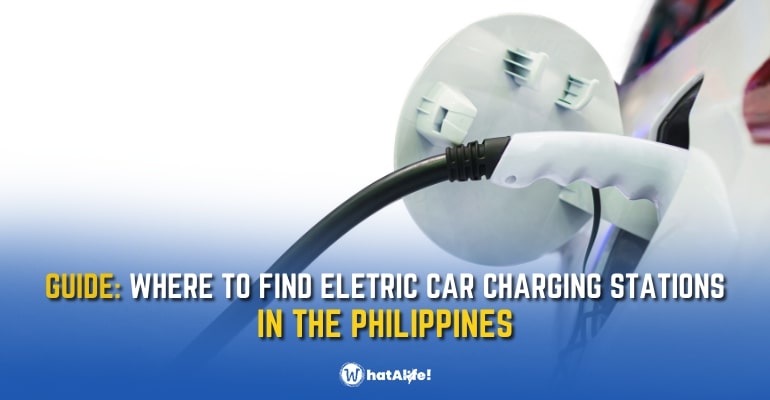Estimated reading time: 5 minutes
Moving up to a cleaner future, electric cars are accelerating in popularity worldwide. With an increasing awareness of the need to reduce our carbon footprint and protect the environment, more and more people are turning to electric vehicles as a sustainable alternative to traditional gasoline-powered cars. If you’re an electric vechile owner in the Philippines, here is a guide to help you find electric car charging stations in the country.
Table of contents
What are Electric Cars?
An electric car is a type of vehicle that is powered by an electric motor instead of an internal combustion engine that runs on gasoline or diesel fuel. Instead of a traditional fuel tank, electric cars are powered by a rechargeable battery pack that provides energy to an electric motor. Electric cars produce no tailpipe emissions, and they are considered to be more environmentally friendly than traditional cars, especially when powered by renewable energy sources like solar or wind power. Additionally, electric cars are often more energy-efficient and cheaper to maintain than gasoline-powered vehicles.
Electric Car Charging Stations
Electric car charging stations are the infrastructure used to recharge electric vehicles. They are typically located in public places like parking lots, malls, and gas stations. There are three types of electric car charging stations: Level 1, Level 2, and DC fast charging.
Level 1 charging stations use a standard 120-volt household outlet and can take up to 20 hours to fully charge an electric car. Level 2 charging stations use a 240-volt circuit and can charge an electric car in 4-8 hours. DC fast charging stations use direct current to charge an electric car in under an hour.
What Are the Top Benefits of Electric Cars?
Electric cars offer several benefits over traditional gasoline-powered vehicles, including:
- Environmental friendliness: Electric cars produce no tailpipe emissions, which means they don’t emit harmful pollutants into the air like carbon monoxide, nitrogen oxides, and particulate matter. They also contribute less to greenhouse gas emissions, which are a major contributor to climate change.
- Lower operating costs: Electric cars have lower operating costs than gasoline-powered cars because they use electricity, which is generally cheaper than gasoline.
- Energy independence: Electric cars can be powered by renewable energy sources like solar or wind power, which means they can help reduce our reliance on fossil fuels and imported oil.
- Quieter and smoother ride: Electric cars are typically quieter and smoother than gasoline-powered cars because they don’t have an internal combustion engine, which generates noise and vibration.
- Incentives and tax credits: Many countries offer incentives and tax credits for buying electric cars to encourage the adoption of clean energy and reduce emissions.
Where can you find electric car charging stations in the Philippines?
There are several ways to find electric car charging stations in the Philippines. The most common way is to use online maps and directories that list the location and availability of charging stations. Popular online maps and directories include:
Below is a list by goflatout.ph of electric car charging stations in parts of the Philippines:
AC Charging Stations (Updated January 30, 2023)
NCR
- SM Aura, B1 Parking
- SM City BF Parañaque
- SM City Bicutan
- SM City Fairview
- SM City Grand Central
- SM City Manila
- SM City Marikina
- SM City San Lazaro
- SM City Sta. Mesa
- SM City Valenzuela
- SM Mall of Asia, 3rd Level North Parking Building
- SM Megamall
- SM North EDSA, 3rd Level North Parking Tower
- SM Southmall
- The Podium
- Ayala Triangle Gardens Tower Two
- Ayala Malls Vertis North
- Circuit Makati
- Seda Hotel BGC
- Greenbelt
- Glorietta
- Alabang Town Center
- Trinoma
- Unioil EDSA Guadalupe
- Unioil Congressional Avenue
- Fairmont Makati
- Robinsons Galleria
- Luzon
- SM City Baguio
- Solaris One Baguio Technohub
- Solenad, Nuvali (Laguna)
- Laguna Technopark
- Vermosa (Cavite)
- Unioil Subic (soon to open)
- ACEA Subic
DC Fast Charging (Updated November 29, 2022)
Luzon
- Shell Recharged Mamplasan, SLEX Northbound
How do you plan ahead when driving an electric car in the Philippines?
Planning ahead is essential when driving an electric car in the Philippines, especially when traveling long distances. EV owners should research the location of charging stations along their route and plan their stops accordingly. They should also keep in mind the type of charging station they will need, as not all stations offer the same charging speeds.
When planning a trip, EV owners should also take into account the weather conditions, as extreme temperatures can affect the range of an electric car. It’s also a good idea to have a backup plan in case the charging station is out of order or in use when you arrive.
Closing
Finding electric car charging stations in the Philippines can be a challenge, but it is a critical step toward promoting the widespread adoption of electric cars in the country. By utilizing the various resources available, such as mobile apps and online directories, electric car drivers can find charging stations and plan their routes accordingly.
As more charging stations are installed, and the infrastructure for electric cars improves, we can expect to see more drivers switch to electric vehicles, reducing the country’s dependence on fossil fuels and contributing to a cleaner and more sustainable future. –WhatALife!/Jayve

Leave a Reply